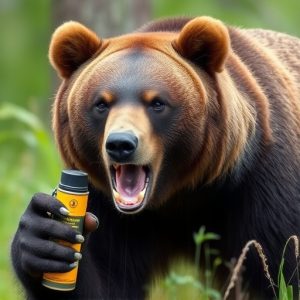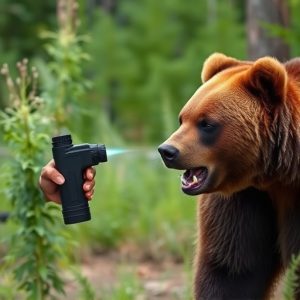Bear Spray Range & Durability: Navigating Safety, Effectiveness, and Environmental Impact
Bear spray is a crucial safety tool in bear country, effective at repelling bears within 20-30 feet…….
Bear spray is a crucial safety tool in bear country, effective at repelling bears within 20-30 feet when used correctly. Its potency depends on active ingredient concentration, application technique (aiming for the face and eyes), and weather conditions. The duration of protection varies based on soil contamination, storage, and repellent type, lasting up to several minutes but not guaranteed in all conditions. Adhering to manufacturer instructions and minimizing environmental impact through proper disposal is vital, especially considering the potential for bear spray soil contamination that can reduce its effectiveness and harm ecosystems. Effective usage requires strategic application within recommended ranges, as local guidelines vary based on bear species and environment.
Alaska’s rugged wilderness attracts adventurers, but it also harbors bears. Understanding bear repellent effectiveness, especially maximum range and duration, is crucial for safety in this vast landscape. This guide explores bear spray basics, its environmental impact through soil contamination, and best practices. We demystify ‘maximum range,’ revealing what it truly signifies, and discuss the critical factor of duration. By equipping you with knowledge, we aim to enhance your experience while ensuring responsible use of bear spray in Alaska’s natural realm.
- Understanding Bear Spray: The Basics of Effectiveness
- Soil Contamination: How Bear Repellents Impact the Environment
- Maximum Range: What Does It Really Mean?
- Duration of Protection: How Long Does Bear Spray Last?
- Best Practices: Using Bear Spray Safely and Effectively
Understanding Bear Spray: The Basics of Effectiveness
Bear spray, also known as bear repellent, is a crucial tool for anyone venturing into bear country. Understanding its effectiveness and proper usage is essential to ensure maximum safety during outdoor activities. The key to bear spray lies in its active ingredient concentration, application technique, and weather conditions.
When it comes to range, bear spray’s effectiveness is influenced by factors like the sprayer’s skill, wind direction, and the size of the bear. However, most high-quality bear sprays advertise a protective range of around 20-30 feet (6-9 meters). It’s important to note that proper application techniques, including aiming for the face and eyes of the bear, significantly enhance its potency. Bear spray’s duration varies based on factors like soil contamination and storage conditions, but when used correctly, it can deter bears for several minutes, providing a critical window for escape or safety measures.
Soil Contamination: How Bear Repellents Impact the Environment
Bear spray, a popular bear repellent, is designed to create a barrier between humans and bears, but its impact on the environment, particularly soil contamination, is an important consideration. When used correctly, bear spray can be effective in deterring bears from approaching, reducing potential conflicts. However, improper use or disposal of these repellents can lead to environmental harm. The chemicals present in bear spray, intended to disrupt a bear’s sense of smell and vision, may persist in the environment if not properly contained.
Soil contamination occurs when these chemical agents seep into the ground, affecting plant life and potentially entering water bodies. The duration of this impact varies depending on factors like the type of repellent, local soil conditions, and weather patterns. It’s crucial to understand that bear spray should only be used as a last resort and applied according to manufacturer instructions to minimize environmental damage. Responsible usage and proper disposal methods are essential to mitigating soil contamination and preserving the ecological balance in areas where bears inhabit.
Maximum Range: What Does It Really Mean?
The maximum range of a bear repellent, often touted as its effectiveness distance, is a topic of great interest for outdoor enthusiasts and Alaskan residents alike. However, understanding what this range truly signifies is essential. When we talk about the maximum range of bear spray, it doesn’t refer to a static, unchanging distance. Factors like wind speed and direction, terrain, and even the specific chemical composition of the spray greatly influence its reach.
Bear spray, when used properly, creates a cloud that can dissipate rapidly in ideal conditions, lasting anywhere from 4 to 7 seconds on average. This duration offers a crucial window for escape or deterrence. But remember, these numbers are approximations; actual performance can vary significantly based on the aforementioned variables. It’s crucial to note that even if the spray reaches beyond what’s considered the ‘maximum range,’ its effectiveness decreases dramatically as the distance increases due to soil contamination and evaporation of the active ingredients.
Duration of Protection: How Long Does Bear Spray Last?
The duration of protection offered by bear spray is a crucial consideration for anyone venturing into Alaska’s wilderness. Unlike other repellents, bear spray is designed to provide an immediate and effective deterrent when sprayed directly in an animal’s face. However, its effectiveness is not indefinite. The length of protection depends on various factors, including the quality and brand of the spray, environmental conditions, and how it’s used.
In ideal conditions, a single can of bear spray typically offers around 20-second pulse of protection, giving users time to create distance from an approaching bear. But remember, bear spray soil contamination is a real concern. The spray particles can settle on the ground or linger in the air, reducing its effectiveness over time and potentially contaminating the environment. Always follow manufacturer guidelines for proper usage, storage, and disposal to maximize the spray’s longevity and minimize ecological impact.
Best Practices: Using Bear Spray Safely and Effectively
When using bear spray, safety and effectiveness go hand in hand. Always remember to keep your back to the bear and point the nozzle away from yourself and others before activating the spray. The ideal application is a 7-second burst from a distance of 20-30 feet (6-9 meters), creating a barrier of bear repellent spray around you. It’s crucial to understand that bear spray is not a bulletproof solution; it only provides a temporary deterrence, usually lasting up to 45 seconds.
To maximize the effectiveness and avoid soil contamination—a common issue that can reduce the spray’s range—make sure the nozzle remains untouched until use. Contaminants like dirt or debris can interfere with the spray’s reach and potency. Additionally, bear spray is most effective when used against brown bears, which are more sensitive to its irritant properties compared to black bears. Always follow local guidelines and regulations regarding bear repellent usage, as duration and application methods may vary based on specific environments and bear species.
Choosing the right bear repellent, like those with a proven maximum range, is essential for outdoor enthusiasts in Alaska. Understanding the environmental impact of soil contamination from these products is crucial, as it ensures their safe and effective use without long-lasting harm to nature. Moreover, knowing the duration of protection offers peace of mind while exploring bear country. By adhering to best practices, users can maximize the potential of bear spray, enhancing safety during outdoor activities while minimizing environmental risks.


